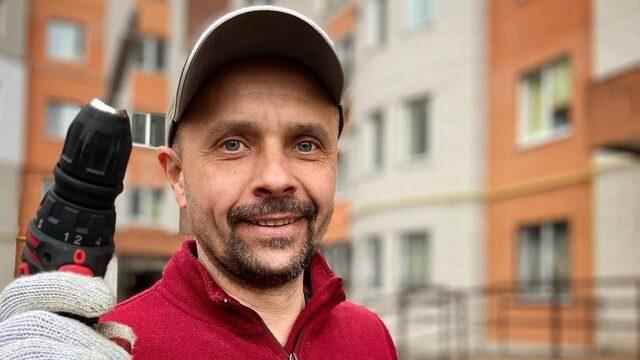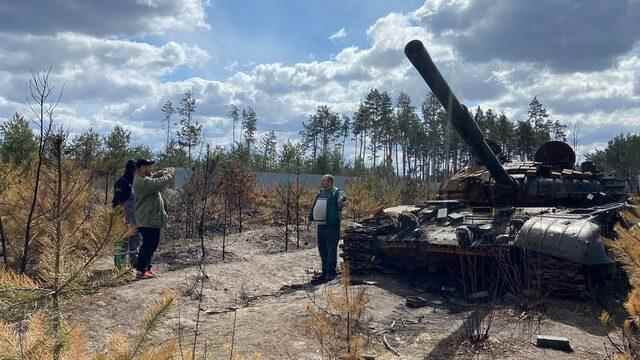The sound of chainsaws echoes in the common garden of an apartment in Buça.
The steam of the water boiled in a wood fire on one of the door sills mixes slowly with the heavy air of the city.
However, in this once lively garden, the voices of children echoed, not chainsaws.
But everything has changed since the Russians came.
Most people fled and did not return. Only a handful of determined people are left behind. Now they are the ones who are trying to remove the debris from the city.
Sergey and his wife are among those who returned after fleeing the city. Five days ago, they got their flat again. Together with their neighbors, they are trying to rebuild their damaged houses and clear the streets of countless Russian ammunition and debris.
“You always want to go home,” he says.
“We returned at the first opportunity. We wanted to make sure our home was safe. Thieves in the area could also steal something.”
Sergey takes me to a grave in the shadow of the apartment. Right next to it, it is possible to see the deep traces left by Russian tanks in the mud.
Here lies the body of his neighbor, who was killed while photographing Russian soldiers in the area.
His name and date of death are written on a piece of wood.
He says the first thing he does when he gets home is to show his neighbor the respect he deserves and dig a grave for him.
not safe yet
For those living in Buça, death has become a habitual part of life in just a few weeks.
Denis Davidoff, who was there when the city was occupied, says that when they went out on the streets after the Russians withdrew, they saw terrible things.
People from all over the world were thrown into the streets, some reacting to photos of corpses with their hands tied behind their backs.
Denis, on the other hand, says that he saw these scenes with his own eyes:
“When I went out on the street, I saw corpses. As I was walking by, I realized that there are corpses everywhere.
“I wasn’t scared, but it was a very intense feeling. We were used to it for a month under the occupation.”
While the world condemned what was done in Bucha, Russia said it was a fiction and argued that the bodies were placed after the Russian army withdrew.
But Denis says he witnessed everything:
“Some of the bodies remained on the ground for so long that after the rain, sand and earth began to cover them.
“At one point I realized that some of these bodies belonged to people I knew.”
The people of Buça are still trying to comprehend the extent of the destruction that has befallen them.
Moreover, they are still not safe. More than 3,000 unexploded ordnance has been found around Kyiv since Russia began withdrawing.

In a nearby village, we see a roadside ditch. It has 20 explosives placed in an orderly manner. A plastic warning strip has been drawn around it so that the bystanders do not approach it by mistake.
Making these cities completely safe to return to will be a very difficult task.
There is no quiet moment
There is an unusual cemetery on the side of the road leading to Buça. This is the cemetery of wrecked Russian military vehicles.
During the conflict, this place was used as a defensive camp. The ruins show that soldiers lived here.
There are packs of groceries, bottles of vodka, panties and socks.
Also left behind is a sleeping bag in a color that would go against camouflage, bought from a store by a soldier in need of warmth.
A box of shower gel and a toothbrush stand by the campfire.
I find partially burnt papers with inscriptions in Russian.
After browsing the articles, our local producer Ilya says these are the remains of a fighting and survival guide given to Russian soldiers.
Obviously, what was explained in the guide did not work here.

There is not a single quiet moment here. Cars and trucks slow down as they cross the road, drivers turn their heads to get a better view of the wreckage.
Locals flock to the armored cemetery and take pictures with the remains of the vehicles.
Arm fragments of Russian soldiers on the grass, charred meat and leather scraps do not prevent this.
We notice that inside one of the tanks is a badly burned body. It is difficult to even understand that the body belongs to a human.
Some of the visitors are starting to take pictures of the corpse.
In time, all these will be removed and the roads will be restored.
Bodies will be buried, broken glass replaced, and buildings repaired.
In the end, nothing will be left of the physical traces of this brutality.
But their memories will not be erased from the memory of the people of Bucha.
